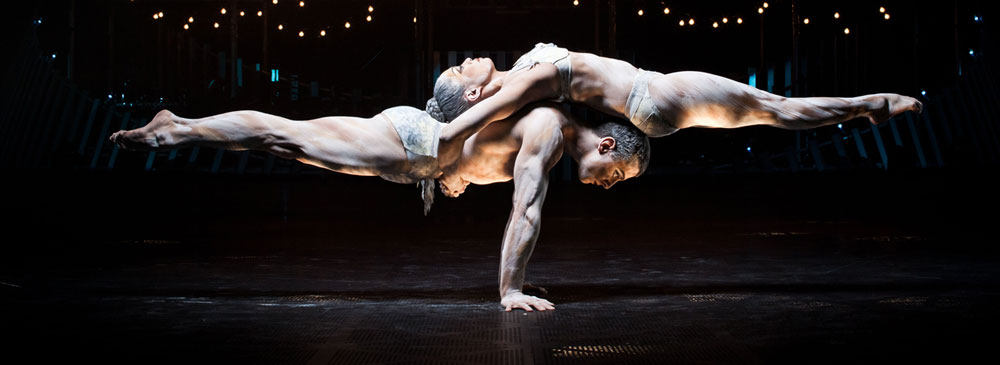Cirque du Soleil skips to Colorado: Out Front’s interview with show’s ‘skip-rope’ performer

Since the age of 12, Adrienn Banhegyi has been skipping her way around the globe.
Before she became a rope-skipping champion with two world records under her belt – and before she became the charming, rope-skipping star of Cirque du Soleil’s “Quidam” – Benhegyi was the Hungarian daughter of an elementary school fitness teacher who was looking for a new exercise routine to introduce to his class.
Known here in the States as “jump rope,” to the Europeans rope skipping has become a cultural phenomenon, spawning regional and international championship competitions. Though when Banhegyi’s father introduced the sport to her gym class, it was fairly new to the area.
“The goal was to do a little performance to show the people what we learned,” Banhegyi said, discussing how she and her father turned rope skipping into a dance performance. “It was going to be a small Christmas show. Then it started to grow, and other schools wanted to try it. Then we found out about the Rope Skipping Federation in Europe and around the world.”
Ten-year-old Banhegyi and her father went to a rope-skipping competition and were dazzled by an American team’s advanced skills.
“They were very good. Since the sport originated there, they were doing all these crazy tricks. We saw where the level was, and it was a lot higher than we were at that time. So it was a nice motivation for me to learn.”
Naturally competitive, Banhegyi began training regularly, entering local contests, and eventually moving to European events and making a name for herself. In time she would become one of the most recognizable faces in rope-skipping, taking home the European championship title five times and the World Championship three times. Currently, she holds the world record for most consecutive “triple-unders” (passing the rope underfoot three times without touching the floor), soaring past the competition with a staggering 330 passes.
After spending 15 years dominating competitions in the U.S., Australia, Japan and all across Europe, Banhegyi had, by her mid-20s, seemingly climbed every mountain her field had to offer. After spending some time teaching children and other athletes the joys and physical challenges of rope-skipping, she came across a television performance of Cirque du Soleil. Seeing the transition from competitor to performer as the natural progression of her rope-skipping talent, Banhegyi submitted an audition video of herself to the organization.
Formed in Baie-Saint-Paul, Canada, in 1984 by street performers Guy Laliberté and Gilles Ste-Croix, Cirque du Soleil has become a cultural touchstone of the entertainment world, dominating the genre as one of the most recognizable names in the performing arts. Since its time as a humble, single-show Canadian operation, Cirque now boasts 21 shows in more than 40 countries with annual revenue of $810 million. It is estimated that 90 million people have experienced Cirque du Soleil, with a show going on somewhere in the world almost every day of the week.
Assembling only the best physical performers in the world, Cirque du Soleil has developed a reputation of exceeding audiences’ ever-growing expectations. Not so much a touring show as a traveling city, any single Cirque operation requires a traveling coordinator to book 100 hotel rooms in each city, with 15 semi trucks moving just the equipment and a series of buses moving the performers. They perform for 10 weeks at a stretch – often doing two shows a day – with two weeks off, requiring the coordinator to book flights home and back for the performers, who are scattered throughout 23 different countries.
Always on the prowl for athletes who have proven themselves the best in their field, the producers of Cirque du Soleil were sufficiently impressed with Banheghyi to place her in their “Quidam” show.
In operation since 1996, ”Quidam” tells the story of a young girl named Zoé, who, disenfranchised from life with her stringent parents, disappears into a surreal world of imagination and adventure. During this odyssey, Zoé encounters “the skipping girl,” who introduces her to “a playground atmosphere, the joy and nostalgia of being a little girl, where you can play around and have fun jumping rope,” Banhegyi explained.
As the skipping girl, Banhegyi is joined on stage by 20 other rope skippers, all but one of them having no previous training in the craft. “Those guys look like they can do anything in the world,” she said of training her co-stars to perform with a jump rope, “but it’s funny, you give them a jump rope and it’s real hard work for them. They’re super fit and can throw each other in the air, but it’s hard work to turn the rope inside the rhythm and do their acrobatic moves inside the rope.”
Facing down the challenge of a grueling tour schedule inside a demanding, world-renowned show, Adrienn Banhegyi, now 29, has successfully made the transition from rope-skipping competitor to rope-skipping performer, bringing international respect to a craft often dismissed as a child’s pastime.
Now that she’s conquered the world of performance skipping, Banhegyi is considering a return to competition. Six years ago, her record for most triple-unders was painfully close to being surpassed, with her challenger reaching 329 jumps, just one shy of the title.
“When I did my 330, I didn’t stop because of a mistake, I wasn’t tired, I just had other events to do. And it seemed like a good number since the others were 200 jumps behind,” Banhegyi said. “At that point I was just breaking my own record each year. But now someone is getting close. I think I might return next year to put the number a bit higher. Just in case.”
What's Your Reaction?
Josiah Hesse writes music, feature interviews and news coverage for Out Front Colorado.










